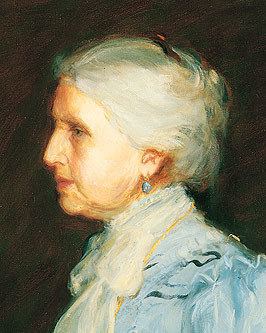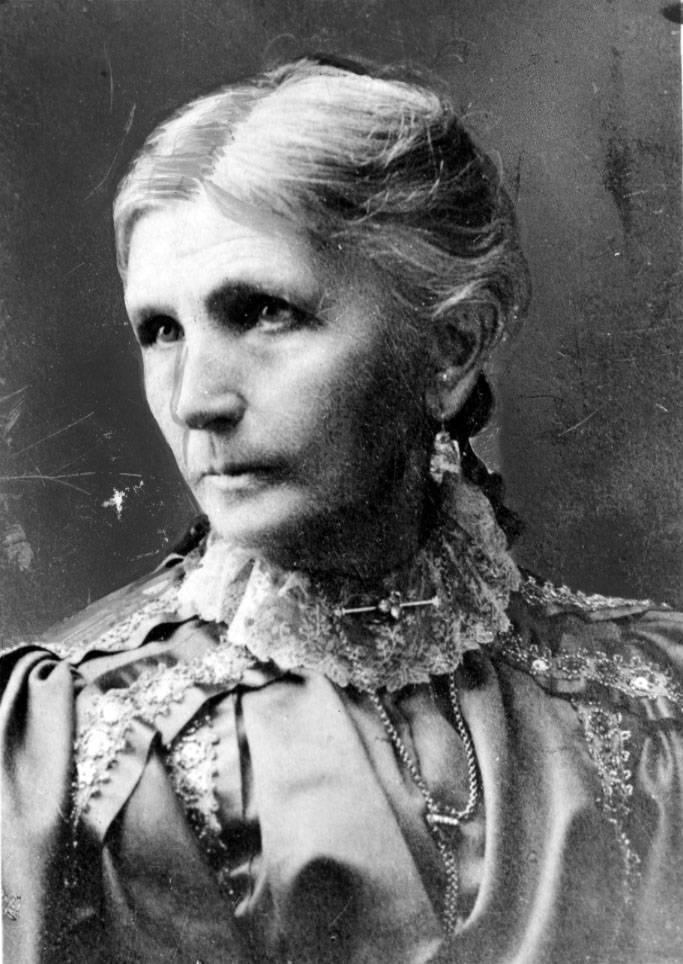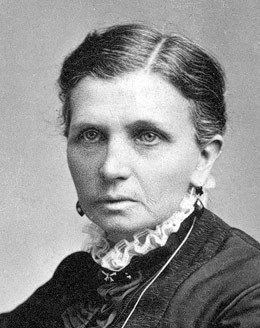Role Journalist | Name Emmeline Wells Cause of death Stroke | |
 | ||
Full Name Emmeline Blanche Woodward Born February 29, 1828Petersham, Massachusetts, United States ( 1828-02-29 ) Resting place Salt Lake City Cemetery40°46′38″N 111°51′29″W / 40.7772°N 111.8580°W / 40.7772; -111.8580 (Salt Lake City Cemetery) Spouse(s) James HarrisNewel K. WhitneyDaniel H. Wells Children 7 Harris - 2 Whitney - 2 Wells - 3 Parents David and Deiadama H. Woodward Similar People Daniel H Wells, Newel K Whitney, Rulon S Wells, Heber Manning Wells, Heber J Grant | ||
Carol Cornwall Madsen--"Emmeline B. Wells" (Benchmark Books, 7/19/17)
Emmeline Blanche Woodward Harris Whitney Wells (pronounced em-ma-līn) (February 29, 1828 – April 25, 1921) was an American journalist, editor, poet, women's rights advocate and diarist. She served as the fifth Relief Society General President of The Church of Jesus Christ of Latter-day Saints (LDS Church) from 1910 until her death.
Contents
- Carol Cornwall Madsen Emmeline B Wells Benchmark Books 71917
- A Woman and Her Words The Personal Writings of Emmeline B Wells
- Early life
- Marriages
- Contributions
- Womens suffrage
- Church service
- Articles
- Poetry
- References

A Woman and Her Words: The Personal Writings of Emmeline B. Wells
Early life

Emmeline Blanche Woodward was born in on February 29, 1828 in Petersham, Massachusetts. She was the seventh child of David and Deiadama Hare Woodward. Her father died when Emmeline was four years old. She would later claim that her widowed mother inspired her to be woman's rights advocate. As a child, she wrote poems and stories which she shared with her friends. She often enjoyed being in nature. Woodward was very intelligent and began studying in public school until she enrolled in the New Salem Academy. She graduated from the Academy at the age of fourteen. She taught school briefly before her first marriage at the age of fifteen. Woodward joined The Church of Jesus Christ of Latter-day Saints on March 1, 1842.
Marriages

She married 16-year-old James Harris, also a new member of the church, on July 19, 1843. In 1844, the young couple, his parents, and other Latter Day Saints from their region migrated to the headquarters of the church, Nauvoo, Illinois. After the death of their infant son, Eugene Henri, Harris left Nauvoo looking for work and never returned.

The young Emmeline Harris returned to teaching. Through his children attending her school, Harris met and later married Newel K. Whitney, a significantly older man, under the Mormon practice of plural marriage. Emmeline Whitney left Nauvoo in 1846, and traveled to Utah Territory with the extended Whitney family in 1848. At this time, she began maintaining a personal journal. Wells would continue writing in her diaries (forty-six journals are known) until 1920, shortly before her death. On the first page of volume 1, dated Friday, February 27, 1846, she recorded:
Whitney's death in 1850 left her with two young daughters, whom she supported by again teaching school in Salt Lake City. She remained primarily responsible for supporting herself and her children for the rest of her life.
Emmeline Whitney approached Daniel H. Wells, a friend of her late husband and a prominent civic leader, about marriage. In 1852, she became his seventh wife, bearing him three daughters. Their early marriage was distant, as Daniel Wells was heavily involved in civic and church duties and had six other families. However, later in their lives, the couple became fond and loving companions.
Contributions
Wells was the editor of Utah's Woman's Exponent, a semi-monthly periodical established in 1872 for Mormon women. Wells was a contributor to the magazine from its inception, but for its first five years of existence the editor was Louisa Greene Richards. Wells became the associate editor in 1875 when Cornelia H. Horne ended her term as business manager. Wells was the editor from 1877 until the publication ceased in 1914. As editor she wrote all the editorials, many of the articles and most biographical sketches contained in the publication. Near the end of her tenure as editor Wells had the assistance of her daughter Annie Wells Cannon as assistant editor.
Wells also wrote numerous short stories and poems, many of which were published. She later compiled her poetry into a single volume, Musings and Memories. In 1912 she became the first Utah woman to receive an honorary degree, in literature, awarded her by Brigham Young University.
Women's suffrage
Wells became an early advocate of women's rights, writing under the name "Blanche Beechwood" for the Woman's Exponent. "I believe in women, especially thinking women," she wrote. In addition to reporting news of the Relief Society, she used the publication to support woman suffrage and educational and economic opportunities for women. As editor, she became known for her executive talents and her superb memory.
In 1879, Wells was appointed as a Utah representative to a suffrage convention in Washington D.C.. Wells was a delegate to the 1882 Utah State Constitutional Convention, where she served on the committee on education and the committee on schedule and elections. Wells joined the National Council of Women of the United States in 1891 and was the first woman from Utah to hold an office.
Beginning in 1879, Wells advocated that women be granted the right to hold office in Utah Territory. In 1878, she turned down a nomination for Salt Lake County Treasurer from the People's Party because women were not eligible to hold office in the territory. In 1879 she, along with Sarah M. Kimball, urged Governor George Emery to support women holding office, which he declined, and in 1880 she was the leading force involved in convincing Charles W. Penrose to introduce legislation to grant women the ability to hold office.
Wells was active in the national women's suffrage movement, where she served as liaison between Mormon and non-Mormon women and fielded hostile criticism associated with the practice of polygamy. On the national level, she was closely associated with both Elizabeth Cady Stanton and Susan B. Anthony. For nearly thirty years she represented Utah women in the National Woman Suffrage Association and the National and International Councils of Women. Beginning in 1879, with her attendance at a suffrage convention in Washington, D.C., Wells acted as a lobbyist for Utah interests. She met congressmen and presidents and addressed the issues of polygamy and women's suffrage from the Utah woman's point of view. In 1893 Wells was elected president of the Utah Territorial Women's Suffrage Association. Wells was also involved in the ultimately successful effort to restore suffrage to Utah women in the 1896 Utah state constitution. In 1899, Wells was invited by the International Council of Women to speak in London as a representative of the United States.
After Utah gained statehood, Wells did run for election. In a much publicized election, the 66-year-old Wells stood as one of several "at large" Republican candidates for state senator from Salt Lake County. Martha Hughes Cannon, a physician and former employee at the Women's Exponent, was one of five Democrats running for the office. On November 3, 1896, Cannon defeated the field, and became the first woman ever elected as a state senator in the United States.
Church service
For several years Wells served as the corresponding secretary of the Relief Society.
Wells was selected as general secretary for the Relief Society by president Eliza R. Snow and served for twenty-two years in the position under succeeding presidents. In her youth in Nauvoo, Wells briefly knew Joseph Smith, founder of the church. In 1905, as Relief Society Secretary, she wrote the following to the young women of the church:
Wells was appointed by Brigham Young in 1876 to head a church-based grain-saving program, and managed the church wide program until the beginning of World War I. In 1919, Wells received a personal visit in her Salt Lake City home from U.S. President Woodrow Wilson who presented her a commendation for selling the collected wheat to the government for the war effort.
Wells was called as the Relief Society's general president in 1910 at the age of 82. She served for eleven years, administering service issues related to the world war and dealing with issues relating to growth and administrative expansion. To her sorrow, the Relief Society Board declined to continue their support of the Women's Exponent, and the publication closed in 1914. Ill health led her to be released in 1921, at the age of 93. Wells died three weeks later and was buried at the Salt Lake City Cemetery. Wells's first counselor Clarissa S. Williams succeeded her as Relief Society general president.
Wells authored the text of the Latter-day Saint hymn "Our Mountain Home So Dear", which is hymn number 33 in the church's 1985 English-language hymnal.
A bust of Wells, inscribed "A Fine Soul Who Served Us", is found in the rotunda of the Utah State Capitol. The bust was funded through the efforts of women's groups in Utah, including the feminist community, LDS women's groups, and women's groups from other church organizations and was made posthumously as a tribute to Wells; to date, she is the only woman honored in this way.
